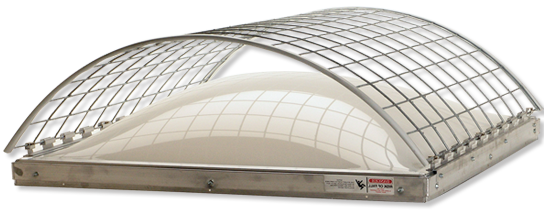NIOSH Alert- Current Standards
CURRENT STANDARDS:
Occupational Safety and Health Administration (OSHA)
OSHA has developed standards to prevent workers in general industry and in construction from falling through skylights and roof and floor openings. The OSHA General Industry Standard requires that “every skylight floor opening and hole shall be guarded by a standard skylight screen or a fixed standard railing on all exposed sides”. OSHA also requires that skylight screens meet the following standards:
Skylight screens shall be of such construction and mounting that they are capable of withstanding a load of at least 200 pounds applied perpendicularly at any one area on the screen. They shall also be of such construction and mounting that under ordinary loads or impacts, they will not deflect downward sufficiently to break the glass below them. The construction shall be of grillwork with openings not more than 4 inches long or of slatwork with openings not more than 2 inches wide with length unrestricted.
If a fixed railing is used instead of a screen, OSHA requires the following:
A standard railing shall consist of top rail, intermediate rail, and posts, and shall have a vertical height of 42 inches nominal from upper surface of top rail to floor, platform, runway, or ramp level. The top rail shall be smooth-surfaced throughout the length of the railing. The intermediate rail shall be approximately halfway between the top rail and the floor, platform, runway, or ramp. The end of the rails shall not overhang the terminal posts except where such overhang does not constitute a projection hazard.
In 1995, OSHA construction industry standards for fall protection were revised and consolidated, and they are currently located in OSHA’s Subpart M-Fall Protection. Workers must be protected as follows:
Each employee on walking/working surfaces shall be protected from falling through holes (including skylights) more than 6 feet above lower levels by PFAS (personal fall and arrest system), covers, or guardrail systems erected around such holes.
Each of these systems is described in 29 CFR 1926.502. The following paragraphs have been reproduced from the OSHA standards to summarize these systems. The full text in OSHA standards should be used to ensure that the fall protection system selected meets all fall protection criteria and practice requirements.
Personal fall arrest system means a system used to arrest a worker in a fall from a working level. It consists of an anchorage, connectors, a body belt or body harness, and may include a lanyard, deceleration device, lifeline, or suitable combinations of these. As of January 1, 1998, the use of a body belt for fall arrest is prohibited.


